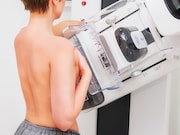DBT yielded lower abnormal interpretation rate, higher positive predictive value 1, higher specificity
FRIDAY, April 5, 2019 (HealthDay News) — In older women, digital breast tomosynthesis (DBT) is associated with improved performance metrics versus digital mammography (DM), although the cancer detection rate is similar, according to a study published online April 2 in Radiology.
Manisha Bahl, M.D., M.P.H., from Massachusetts General Hospital in Boston, and colleagues compared performance metrics of DM and DBT by reviewing consecutive screening mammograms for patients aged 65 years and older. Data were included for 15,019 women in the DM group and 20,646 women in the DBT group.
The researchers observed no difference in cancer detection rate between the DM and DBT groups after adjustment for multiple variables (6.9 versus 8.2 per 1,000 examinations; adjusted odds ratio [aOR], 1.13; P = 0.23). The DBT group had a lower abnormal interpretation rate (5.7 versus 5.8 percent; aOR, 0.88; P < 0.001), higher positive predictive value 1 (14.5 versus 11.9 percent; aOR, 1.26; P = 0.03), and higher specificity (95.1 versus 94.8 percent; aOR, 1.18; P < 0.001) compared with the DM group. Compared with the DM group, the DBT group had a higher proportion of invasive cancers relative to in situ cancers (81.1 versus 74.4 percent; P = 0.06) and fewer node-positive cancers (10.2 versus 16.6 percent; P = 0.054).
“The benefits of screening mammography continue with advancing age, whereas the potential risks of false-positive examinations are lower with digital breast tomosynthesis,” the authors write.
One author disclosed financial ties to GE Healthcare.
Copyright © 2019 HealthDay. All rights reserved.








